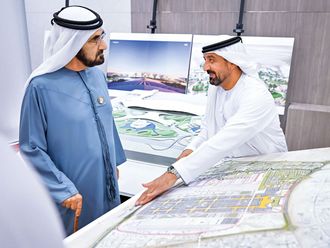
Abu Dhabi: The International Air Transport Association (IATA) expects airline profitability to further deteriorate next year to $4.9 billion (Dh17.99 billion) for a margin of just 0.8 per cent, its director general and chief executive officer Tony Tyler said yesterday.
Addressing the Annual General Meeting of Arab Air Carriers Organisation (AACO) in the capital, Tyler said these are challenging times for airlines.
"The industry made $15.8 billion in 2010 — the most that it had ever made in absolute terms. But the net profit margin was just 2.9 per cent. This year, we expect profits to fall to $6.9 billion for a net margin of 1.2 per cent," he said, adding that on the cost side, "we see limited relief in oil prices — with a slight slip to an average price of $100 a barrel. That will produce a $201 billion bill that consumes on average 32 per cent of costs."
Tyler said there is good reason to expect weakness in demand.
"The European debt crisis continues to deepen. We have not seen the job creation needed to put the US recovery on track. And the challenges of the political situation in the Arab world also could well continue into 2012," he said.
Cargo demand
Tyler said in October the growth of global passenger traffic slowed to 3.6 per cent while cargo demand was 4.7 per cent below previous year levels.
"If we are correct about our 2012 forecast, that will mean that airlines globally since 2001 have lost about $25 billion on aggregate revenues of $5.5 trillion," said Tyler.
He said IATA expects the Middle East carriers to follow the same trend in declining profitability from a $900 million profit last year to $800 million this year and $700 million in 2012.
"But the story for this region is growth. In 2004, Mena (Middle East and North Africa) carriers accounted for less than 7 per cent of international traffic. Today it is over 11 per cent. The double digit growth trend of Middle East carriers over the last years has fuelled this expansion. That has slowed this year," Tyler added.
He said over the first 10 months of 2011, Middle East carriers added 8.8 per cent to capacity while demand grew by 8.0 per cent.
But Tyler said the expectations for the future of Mena are bright.
"We saw this confirmed with aircraft orders topping $60 billion at the recent Dubai Airshow. And the region is preparing well with $100 billion in airport infrastructure investments."
Outlook
Looking ahead, Tyler said robust growth will continue to be a major theme for the Middle East industry.
"For example, the UAE is expecting 8.5 per cent average annual growth through 2015. If that materialises, in 2015, it will handle 86.6 million international passengers, nearly 30 million more than in 2010. And it will be the eighth largest market for international travel, only slightly smaller than China at 90 million passengers and well ahead of Japan at 70 million. This will be an extraordinary achievement," said Tyler.
He said aviation is the lifeblood of the global economy, supporting 33 million jobs and $3.5 trillion in economic activity.
Tyler said the aviation industry is committed to improving fuel efficiency.
Estimates: Turbulence
- $6.9b - profit expected by the industry this year
- $201b - expected fuel bill with oil at $100 a barrel









